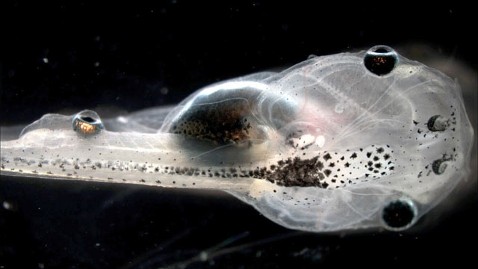Tadpoles 'See' Through Eyes Implanted in Their Tails

Image credit: Douglas J. Blackiston and Michael Levin
Researchers have implanted eyes in the tails of otherwise-sightless tadpoles, and report in a new study that they had some success in getting them to see, or at least detect colored light through them.
The findings, they say, may mean big things in the study of the nervous systems of other animals and even humans.
"The body stores information about its geometric shape and configuration of organs," said Michael Levin of Tufts University in an email to ABC News. "This study was the first in our effort to understand how the brain and nervous system interact with this anatomical information network. We wanted to know if the brain can use data from organs in aberrant locations, so we grafted cells that will make an eye from one embryo (the donor) to another one's tail."
Levin is Director of Tufts' Center for Regenerative and Developmental Biology. He and his co-author, post-doctoral fellow Douglas Blackiston, will have their research published in the March 15 edition of The Journal of Experimental Biology .
So, how exactly was the study conducted?
When a donor eye was grafted to the tail of a tadpole, researchers made note of how the nerves of the eye would grow and attach to the tissue around them. In some cases, the nerves would attach - or innervate - to the spine of the tadpole, sometimes the stomach, and sometimes the eye did not attach itself at all.
A test was then conducted to determine whether the implanted eyes actually worked. The tadpoles were placed in a round chamber with blue light on one side and red on the other. If they swam toward the red light, they got a tiny electric shock. Soon, some of the tadpoles learned to swim toward the blue area - something they would have been unable to do unless they could sense the difference in color.
The tadpoles that successfully avoided the red light were ones whose implanted eyes had connected to the spine, part of the nervous system. If the implanted eye made nerve connections to the stomach, or none at all, the tadpole swam aimlessly - showing it could not tell the difference between red and blue.
Levin said the experiment could have implications for regenerative medicine - "replacing damaged organs with new, properly innervated, functional ones" - or augmenting the senses - "maybe you want an extra eye, one that sees in infra-red or UV perhaps?" He said it might help in the understanding of how bodies evolve, and maybe in the design of future robots.